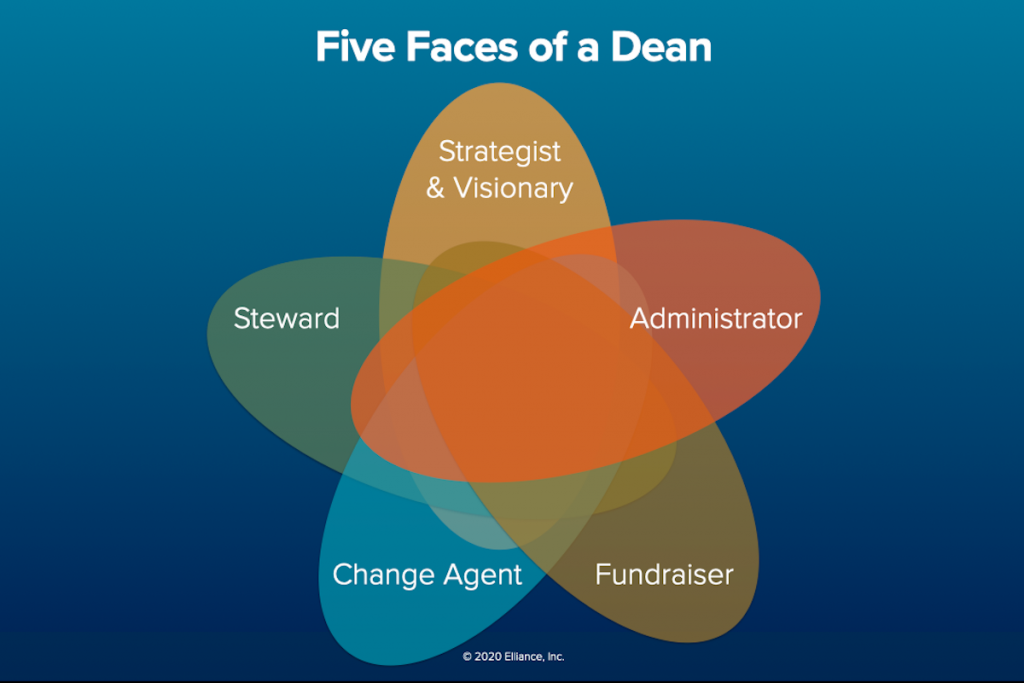| Jan 7, 2020
Five Faces of a Dean

The responsibilities of an academic Dean rival those of a big city mayor. They set strategic direction, gather allies, hunt revenue, champion ideas and ideals, administer day-to-day operations and accrue power. How can Deans best flourish in their current role and prepare for their next incarnation — as college provosts and president?
1. Balance Perspectives
Deans, like mayors, typically arrive on the job with insufficient knowledge. Even as they engage constituents — the listening period — they weigh immediate questions and concerns about revenue, enrollment, donor relations, alumni engagement, student success, reputation and other strategic goals. The challenge: lean into the job without becoming part of the existing culture. Hold on to enough of the outsider perspective to allow for bold decisions, political imagination and a new mythology to emerge.
2. Balance Overt/Covert Change
Schools remain averse to change. Tenured faculty, entrenched staff, squeaky wheel alumni and simple habit all add to the historic weight. To effect change, Deans must be keen observers, strong persuaders, and strategic communicators. The challenge: effectively use key framing questions to challenge old ways; tell stories that project new worldviews; create intelligent frameworks and Key Performance Indicators to challenge assumptions and incentivize believers.
3. Balance Sufficing/Optimizing
Deans rise as high and fast as the talent that they attract and gather. The challenge: don’t settle for status quo approaches or results. Deans claim and/or elevate thought leadership by recruiting, retaining, diversifying and inspiring department chairs, directors of centers of excellence, teaching and research faculty. Deans decide destiny by their willingness to champion a move away from traditional funnel thinking to the wilder and more sustainable shore of existence — true right-fit recruiting that understands the downstream implications for successful outcomes, improved alumni engagement, reputation gains and greater lifetime student value. Deans define their resource pool and political capital by identifying like-minded major gift donors, employers, peers, corporate partners and allies from outside the institution.
4. Balance Data/Story.
Deans understand that perception drives reality. Everything rests on a thin film of understanding, faith and trust. The challenge: recognize that you become the story that you choose to tell. Advancing school rankings, protecting intellectual property, raising academic standards, earning accreditations and securing major gifts require a balance of operating data and imagination. You can’t manage what you can’t measure, and you can’t persuade — prospective students, faculty, recruiters, donors — without proof and the power of a great story.
5. Balance Near/Far
Deans build a donor culture on the power of shared beliefs and purpose. The challenge: approach advisory boards, alumni leaders and key donors with a dual perspective of immediate needs and long-term donor interest and potential. Alignment comes from an ability to imagine and create alongside alumni, foundations, corporate partners and other constituents. Strength comes by cultivating faculty thought leaders to become visible and influential conduits to like-minded donors.
Successful Deans are not lone wolves. They excel as strategists, change agents and fundraisers. They surround themselves with a supporting cabinet of associate deans and a chief-of-staff that help them accomplish their administrative and stewardship roles.
If you are seeking a seasoned partner in your new adventure, please consider contacting us.
